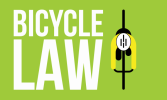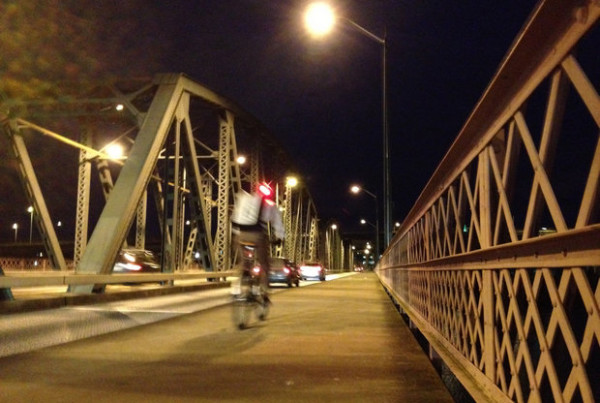Bicycling: We Have Met the Enemy
In many cities and towns, the construction of new bike lanes faces vicious opposition—but the most tenacious obstacle is also the most surprising one
By Matt Seaton
ON THE BIKE PATH I like to use for my morning commute, the one that runs down Ninth Avenue in Manhattan, in the middle of a block between 26th and 28th and right across from PS 33 Chelsea Prep, there’s a signal to allow pedestrians to cross. Except during the school’s frenetic morning drop-off and afternoon pick-up, hardly anyone uses the walkway, so during off-hours the temptation for any momentum-prizing cyclist is to give in to the natural flow of the streets and blow right through the light.
I tend to stop. I’m generally a conformist type, anyway, but I also figure that the one time I don’t brake for an empty walkway there will happen to be a cop nearby, one who is also in a mood to serve me the $270 ticket that is the NYPD’s standard fine for a law that is, at best, haphazardly enforced.
The other day, after I put a foot down, I noticed that for once there actually was a pedestrian at the light. It was an elderly lady, in a long, elegant coat, and she’d obviously been waiting on the sidewalk to see how the onrushing cyclist was going to react to the signal before she stepped into the crosswalk. She looked at me, smiled, and said, crisply but kindly, “Thank you.”
“You’re welcome,” I replied, reflexively.
SUCH A CIVIL, CORDIAL interaction between pedestrian and cyclist starkly contrasts the turbulent reputation New York City earned from installing nearly 300 miles of bike lanes in the past five years—a new focus on bike-centric transportation planning that gave the city a lead role in United States metropolitan cycling advocacy but, simultaneously, sparked such an intense backlash from politicians and residents that clashes between pro- and anti-bike-lane advocates made national news.
The bike lanes were just part of the city’s implementation of a new Department of Transportation policy to calm and decrease automotive traffic, most famously embodied by the changes in Times Square in 2009, when a portion of Broadway was converted into a pedestrian zone. Across the city, store owners said they feared that fewer customers would come, residents lamented the loss of long-used parking spots and voiced fears of being injured by reckless cyclists, and drivers vocalized resentment over losing part of the already overcrowded roadways.
The controversy reached its apogee in a battle over a bike lane installed in one of the wealthiest areas of Brooklyn, across the street from the Prospect Park West residence of a powerful opponent, Iris Weinshall, who was the city’s former transportation commissioner and is married to United States senator Chuck Schumer. Two groups of plaintiffs demanded the removal of the lane, and the fight went all the way to the state supreme court.
The transportation commissioner who had sparked the changes after her appointment back in 2007 and refused to back down from the well-connected Prospect Park West opponents, Janette Sadik-Khan, was called a “psycho bike lady” by a New York Post columnist and dubbed “an incompetent, overpromoted, overzealous bureaucrat who wields power like a chain saw.” A more highbrow voice,New Yorker writer John Cassidy, dedicated a series of blogs to the elaboration of how mayor Michael Bloomberg “plays Robespierre to Sadik-Khan’s Saint-Just” for the pro-bike “Jacobins.” The New York Times reported that Anthony Weiner (back then still a rising political star and congressman rather than a disgraced sexter) said to Bloomberg at a reception, “When I become mayor, you know what I’m going to spend my first year doing? […] I’m going to have a bunch of ribbon-cuttings tearing out your [expletive] bike lanes.”
Thanks to all those high-profile publications and names, when the court ruled in August 2011 that the lane would stay, that otherwise unremarkable bike path became international news.
Since then, as Sadik-Khan told me when we met at her office overlooking New York Harbor, “People are starting to vote with their pedals.” She said studies show cycling use has doubled in the last four years, and cited a Quinnipiac University poll that showed that 59 percent of all New Yorkers—not just cyclists—approve of expanding the bike-lane program.
And, indeed, as I stopped and talked to residents while riding around the city, the overall tenor seemed more upbeat than it had during the initiation of the program, or at least lacking the blatant vitriol. Charisse, a realty agent I spoke with in the Chelsea district of Manhattan, said of the lane there, “I like it. It makes this more of a neighborhood.” Elsewhere, an older resident, Frances, told me that having a bike lane had made things better for her: “It’s improved. Most cyclists stay in the bike lanes, so you know where you’re going to find them.” I asked her if she ever felt threatened by what’s known as “salmoning,” or bikers riding the wrong way in a lane. “I mind it,” she admitted. “But it’s not terrible. You have to look both ways. There are worse things.”
My informal poll found one person who could be described as a critic: Moe, who runs a cell-phone franchise on a busy avenue in Manhattan, said that as a driver he resented the lanes because of the loss of space, and especially because “no one uses them. The bike lanes are not respected by drivers. Or by bikers—they’re still on the sidewalks.” He also said he finds making left turns through bike lanes hair-raising: “I’ve never hit anyone, but I’ve had a few close misses.” But he added that his business had not suffered at all.
This general acceptance, even following such heated resistance, is no surprise to longtime city planners and transportation experts.
Gabe Klein is now the transportation commissioner for Chicago, but until 2011 he was the head of transportation in Washington, DC, where he not only put in miles of bike lanes and implemented a highly successful bike-share program, but also revived a streetcar system that faced opposition as stiff as the bike lanes in New York had. “The backlash in New York City had little or nothing to do with bikes,” he told me. Instead, Klein said, it was simply a normal reaction to a change in infrastructure.
Mia Birk, who works for urban design consultants Alta Planning and was formerly the bicycle-program manager for Portland, Oregon, agreed. “In my experience,” she said, “it is normal for there to be a backlash to changing built infrastructure and doing things a different way, particularly as it relates to people driving. Seattle had a huge controversy; Toronto, too. I see it again and again.”
Tom Vanderbilt, author of the New York Times bestseller Traffic: Why We Drive the Way We Do (and What It Says about Us), said, “A Harvard researcher talks about the ‘four stages’ of social norm change: silly, controversial, progressive, then obvious. In the first stage, we had a sort of reflexive denial: New York isn’t Europe, that won’t work here, etc. I think we’re somewhere between the second and third stage when it comes to cycling in New York; opponents are finding they can’t make viable arguments against cycling as a transportation mode on safety or traffic-flow reasons, so now it’s more about the left-wing, Copenhagenizing cabal.”
In the fourth stage, Vanderbilt explained as I joined him on a weekend ride out of the city to the pretty town of Nyack, on the Hudson River, changes such as bike lanes are widely considered not just positive elements but so desireable as to be obvious needs.
So what’s holding us back? (And we do have a long way to go: Only 0.6 percent of New York City commutes are made by bike.)
Curiously enough, the barrier to progress just might lie in that “thank you” I received the day I stopped to let that kindly old woman cross the bike lane.
AS I RODE AROUND the bike lanes, I stopped to talk to Robert, who runs an art-poster gallery on Eighth Avenue in Manhattan. He is basically supportive of lanes: “Theoretically, they’re wonderful,” he said. But he added: “It’s dangerous. I’ve come so close to being clipped so many times.”
The urban design consultant Birk told me, “I’ve been to probably a thousand public meetings. At every single one of them, the issue of bicyclists behaving badly comes up.”
Vanderbilt told me this common, mass villification of cyclists is “social categorization psychology,” and permits “othering.” I think it’s even more complicated. Which of us can say we’re not guilty of at least occasionally reinforcing the stereotype? That we haven’t rolled a stop sign or gone the wrong way down a street to save going round the block?
Actually, there may be one blameless rider. Ken Podziba told me he stops punctiliously at every red on his way to work across Central Park—even at 7 a.m., when the roadway is closed to vehicles. But he has more incentive than most: It would be embarrassing, to say the least, if someone posted footage on YouTube of the president and CEO of Bike New York—the nonprofit best known for putting on the Five Boro Bike Tour—crashing reds in the park. His self-imposed zero-tolerance approach perhaps gives him a clarity on the subject—or at least allows him to speak categorically: “The backlash was a direct result of cyclists who don’t abide by the rules,” he said.
When cyclists are few and the roads obviously hostile and dangerous to us, it seems to me that people are more tolerant of our rule-bending and breaking. We are, depending on the region, either so rare as to not register as anything more than an insignficant annoyance, or else just one small part of a generally disobliging experience—like bad weather, or construction, fumes, and noise. But in places such as New York City, where we now have facilities paid for by taxpayer dollars and there are more of us about, our transgressions become more visible—and less forgivable.
Why should it be so unusual for a cyclist to stop at a red signal that he is thanked for it?
It could be that all the new bike lanes anyone could build will only go to waste unless we realize that, as Podziba says, “We need a culture of self-enforcement among cyclists.”
Back at the crosswalk that day, the light changed, and I clipped in and pedaled off. I’d made a good start, I realized, by stopping.

